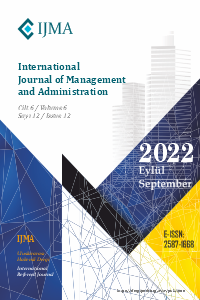ÇİFT YETENEKLİ LİDERLİĞİN ÇALIŞANLARIN İNOVATİF DAVRANIŞLARI ÜZERİNDEKİ ETKİSİ
İnovasyon, Liderlik, Yenilikçi Davranış, Çift Yetenekli Liderlik
THE EFFECTS OF AMBIDEXTROUS LEADERSHIP ON EMPLOYEE’S INNOVATIVE BEHAVIOR
Innovation, Leadership, Innovative Behavior, Ambidextrous Leadership,
___
- Damanpour, F. (1996). Organizational Complexity And Innovation: Developing And Testing Multiple Contingecy Models. Management Science. 42.5, 693-716.
- Damanpour, F. ve D. Aravind. (2012). Organizational Structure And Innovation Revisited: From Organic To Ambidextrous Structure. M. D. Mumford. (Ed.) (2012). Handbook Of Organizational Creativity içinde. New York. Elseiver Inc.
- Isaksen, S. G. ve H. J. Akkermans. (2011). Creative Climate A Leadership Lever For Innovation. Journal of Creative Behavior. 45.3, 161-187.
- Kanter, R. M. (1996). When a Thousand Flowers Bloom: Structural, Collective, and Social Conditions for Innovation in Organizations. P. S. Myers (1996). Knowledge Management and Organizational Design içinde. Boston. Butterworth-Heinemann.
- Rosing, K., M. Frese ve A. Bausch. (2011). Explaining The Heterogeneity Of The Leadership-Innovation Relationship: Ambidextrous Leadership. The Leadership Quarterly. 22, 956-974.
- Rosing, K., M. Frese ve N. Rosenbusch. (2010). Ambidextrous Leadership In The Innovation Process. Innovation and International Corporate Growth. 191-204.
- Scott, S. G. ve R. A. Bruce. (1994). Determinants Of Innovatıve Behavıor: A Path Model Of Indıvıdual Innovation In The Workplace. Academy of Management Journal. 37.3, 580-607.
- Yuan, F. ve R. W. Woodman. (2010). Innovative Behavior In The Workplace: The Role Of Perfonrmance And Image Outcome Expectations. Academiy of Management Journal. 53.2, 323-342.
- Zacher, H., A. J. Robinson ve K. Rosing. (2014). Ambidextrous Leadership and Employees’ Self-Reported Innovative Performance: The Role Of Exploration And Exploitation Behaviors. The Journal of Creative Behavior. 50.1, 24-46.
- Yayın Aralığı: Yılda 2 Sayı
- Başlangıç: 2017
- Yayıncı: Cenk AKSOY
WHİSTLEBLOWİNG İLE MOBBİNG İLİŞKİSİ: KAVRAMSAL BİR BAKIŞ VE ÇÖZÜM ÖNERİLERİ
Fernandes SIMANGUNSONG, Sulthon ROHMADIN
Fatma Zehra TAN, Canan YILDIRAN
KİŞİ-ÖRGÜT UYUMU İLE ÖRGÜTSEL VATANDAŞLIK DAVRANIŞI İLİŞKİSİ: İŞ TATMİNİNİN ARACILIK ROLÜ
ÇİFT YETENEKLİ LİDERLİĞİN ÇALIŞANLARIN İNOVATİF DAVRANIŞLARI ÜZERİNDEKİ ETKİSİ
